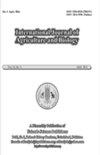Mechanisms of Antimicrobial Resistance in Pseudomonas aeruginosa and a Multi-Pronged Approach to Combat its Infection in Veterinary Science and Public Health: A Review
Q2 Agricultural and Biological Sciences
引用次数: 2
Abstract
Pseudomonas aeruginosa is one of the most important nosocomial pathogens associated with a variety of medical and veterinary infections and therefore, it presents a major public health threat. Different classes of antibiotics are being used to treat its infections which are increasing selective pressure to multi-drug resistance development. Resistance to antibiotics in P. aeruginosa is due to many of the common and unique mechanisms which include: reducing membrane permeability, modification or inactivation of antibiotics, alteration of enzymes, modification of target sites and over-expression of efflux systems. Over or under expression of the genes of porin channels and components of efflux systems play a major role in the resistance mechanisms of P. aeruginosa. To overcome the problem of the emergence of antibiotic resistance, many new strategies are being employed to control infections caused by P. aeruginosa. These include the use of herbs/medicinal plants and phage therapy. With the advent of modern technology, the molecular mechanisms of these alternative therapies are being elucidated and may be used in future to treat P. aeruginosa infections in humans and veterinary clinics. This review thus highlights the mechanisms of antibiotic resistance of P. aeruginosa against the commonly used antimicrobials and also some alternative strategies to control P. aeruginosa infection. © 2021 Friends Science Publishers铜绿假单胞菌的耐药机制及其在兽医科学和公共卫生领域的多管齐下的防治方法综述
铜绿假单胞菌是与各种医学和兽医感染相关的最重要的医院病原体之一,因此,它对公众健康构成了重大威胁。不同种类的抗生素被用于治疗其感染,这增加了对多药耐药性发展的选择性压力。铜绿假单胞菌对抗生素的耐药性是由许多常见和独特的机制引起的,包括:降低膜通透性、抗生素的修饰或失活、酶的改变、靶位点的修饰和外排系统的过度表达。在铜绿假单胞菌的耐药机制中,通道蛋白基因和外排系统成分的过表达或低表达起着重要作用。为了克服抗生素耐药性出现的问题,许多新的策略被用来控制由铜绿假单胞菌引起的感染。其中包括使用草药/药用植物和噬菌体疗法。随着现代技术的出现,这些替代疗法的分子机制正在被阐明,并可能在未来用于治疗人类和兽医诊所的铜绿假单胞菌感染。因此,这篇综述强调了铜绿假单胞菌对常用抗菌药物的耐药性机制,以及控制铜绿假单胞杆菌感染的一些替代策略。©2021 Friends Science出版社
本文章由计算机程序翻译,如有差异,请以英文原文为准。
求助全文
约1分钟内获得全文
求助全文
来源期刊

International Journal of Agriculture and Biology
AGRICULTURE, MULTIDISCIPLINARY-
CiteScore
1.70
自引率
0.00%
发文量
40
审稿时长
5 months
期刊介绍:
Information not localized
 求助内容:
求助内容: 应助结果提醒方式:
应助结果提醒方式:


